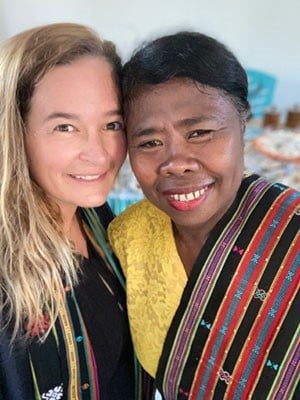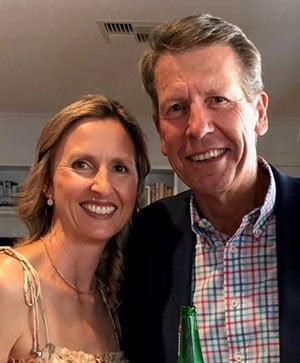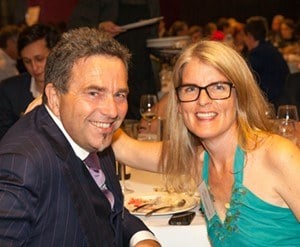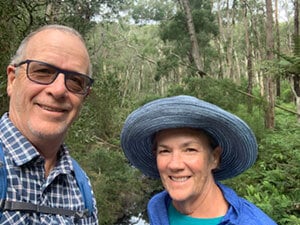Home Articles Client stories How collective giving can maximise impact
How collective giving can maximise impact
Written by Fiona Higgins
‘Giving circles’ (also known as ‘giving groups’) are a form of collective giving that has been gaining momentum in Australia over the past decade. This participatory model involves donors making a specific contribution– ranging from $100 to $10,000 per annum – into a pooled fund, then educating themselves about community issues through social events, seminars and other activities. APS clients are among Australia’s leading advocates for the collective financial, impact, social and educational benefits of giving circles.
Leverage and leadership: Hayley Baillie
‘It’s a great way to make sure your giving dollar goes further,’ explains Hayley Baillie, an APS client who gives through her family’s PAF as well as the Society for Women Leaders, a giving circle established to support the work of the International Red Cross. ‘You truly leverage your funds – when your $10,000 becomes $700,000, suddenly the impact becomes much more significant. Collectively we’ve raised $4,521,000 since the group was established six years ago.’
Apart from amplifying impact through leverage, Hayley points to the social and educational benefits. ‘Through the Society for Women Leaders, I’ve met other like-minded donors and learned about some of the most important issues affecting communities in Australia and overseas. We’ve had direct access to leaders and other inspiring guest speakers with huge experience in the field – from frontline medicos fighting Ebola in Uganda, to earthquake recovery workers in Nepal, to maternal health nurses in Nusa Tenggara Tengah in Indonesia – and it’s been so humbling to contribute to their efforts.’

"You truly leverage your funds – when your $10,000 becomes $700,000, suddenly the impact becomes much more significant."
Hayley and Candra, a prenatal health clinic manager in Wolwal village on the remote Indonesian island of Alor, one of the initiatives supported by the Red Cross Society for Women Leaders
While Hayley’s giving circle contributes exclusively to the work of the Red Cross, other collective giving initiatives – for example, Impact100 chapters across Australia – are ‘cause-agnostic’. Donors work together to determine which charitable organisations to support in their local area by undertaking research, conducting due diligence, then inviting short-listed charities to ‘pitch’ for funding at events hosted by the giving circle.
Seeding a giving circle through matched funding: Geoff Day
‘It took me about 30 seconds to decide that it was something I wanted to get involved in,’ says Adelaide-based APS client Geoff Day, of the Impact 100 model. ‘It was such a simple, compelling proposition– so a group of us got together and established Impact100 SA.’
Now in its seventh year, Impact 100 SA has raised and donated more than $1.5 million for local community programs and, according to Geoff, funding is just the first of multiple benefits. ‘The events themselves are very powerful. By getting our members together in a room, where they listen to a charity representative telling their story – that galvanises donors in a big way. I’ve seen our donors become directors of local charities, become mentors or volunteers, or use their networks more effectively to help charities connect with other charities. The knock-on effect of collective giving is enormous, and it’s about a lot more than just money.’

"The events themselves are very powerful. By getting our members together in a room, where they listen to a charity representative telling their story – that galvanises donors in a big way."
Kate Stock and her father, Geoff Day
The Day Family Foundation also actively seeds giving circles as a creative way of extending their support for some of the organisations they support. ‘Where a charity we’ve supported is interested in establishing a giving circle, in some cases we have offered up a matching grant – typically $10,000 to $15,000 a year for three years to that charity – to help attract initial giving circle members. We’ve done that with JusticeNet SA and Young Adelaide Voices and the 2H project. Matching funding to help grow an early-life giving circle is a very effective way to get other donors on board to support a charity you already love.’
Engaging new gen philanthropists through collective giving: Kate Stock
Kate Stock, Geoff Day’s daughter and a director of The Day Family Foundation, echoes her father’s enthusiasm for collective giving. Over four years, Kate was an officeholder and South Australian ambassador for the unique 10×10 philanthropy initiative, a live crowdfunding platform comprised of young professionals who raise funds for innovative grassroots charities by hosting 100+ guests at inspiring events.
‘When each of the ten committee members invite ten friends into a room and everyone contributes $100 to be there, along with additional corporate and PAF donations, the charities involved can end up receiving between $10,000 or $15,000 each,’ she explains. ‘It’s a win for the charity, but also for the giver. You might only contribute $100 as an individual but, in aggregate, the group ends up distributing $50,000… and that certainly beats a Bunnings barbecue fundraiser on the weekend!’
According to Kate, 10×10 is particularly accessible for younger professionals who are time-poor and interested in a more strategic approach to giving. ‘They might be starting to earn good money, but they don’t have the time to do the due diligence, and they’re also interested in impact. Many of the charities we select at 10×10 are start-ups, so for them the process of being shortlisted, mentored, pitch-coached and connected with others across the sector is transformational – it can be a huge launchpad for smaller, local charities. And for younger people in philanthropy, even those who have had prior experience with family philanthropy through a PAF, 10×10 gives them an accessible, hands-on experience in the sector like no other.’
A source of good projects: Sophie and Paul Chamberlain
Western Australia was the earliest adopter of collective giving in Australia; when Impact100 WA was established in 2012, it represented the first international chapter of the American concept. Sophie and Paul Chamberlain, along with several other givers and James Boyd, State Manager of Creative Partnerships WA who has undertaken research into collective giving in Australia, have been involved from the outset. Apart from the $1.745 million gifted to WA-based not-for-profits since inception, Sophie underlines how Impact100 WA been very useful in delivering a stream of well-researched proposals for her to consider supporting.

"The charities shortlisted are local organisations making a difference in the community we live in – so we can see, touch and feel the difference."
Paul and Sophie Chamberlain
‘I really think that Impact100 is the most amazing source of suggestions for suitable donation recipients,’ observes Sophie. ‘All the due diligence is already done, the organisations have already outlined and substantiated their needs, and there is a good rapport established for donors to build on. The charities shortlisted are local organisations making a difference in the community we live in – so we can see, touch and feel the difference. Impact100 WA is highly place-based, which means we get to access the work directly. And we do – we run 10 site visits a year for our members, so we see our donors becoming more and more engaged. And for most donors, when you start getting a bit more involved with your giving, you don’t want to stop.’
Deepening the joy of giving in retirement: Megan and Arthur Criddle
For Megan and Arthur Criddle, their involvement in collective giving coincided with their establishment of a Giving Fund in 2018. Since then, they have continued both types of giving – through their giving fund within the APS Foundation, as well as through Impact100 WA.
‘Impact100 WA has enabled us to find other, smaller local organisations with exciting ideas and potential for growth. It’s given us the opportunity to form more personal relationships, which in turn has enabled us – through our Giving Fund – to support those organisations that we have a particular interest in.’

"A giving fund takes away the stress of balancing personal financial sustainability against continuing to give when your income diminishes."
Megan and Arthur Criddle
Further, both forms of giving have been a source of deep joy and satisfaction in their (relatively recent) retirement years
‘When you are still working, giving comes with the benefit of tax deductibility. There is a risk that when you stop working and you lose that benefit, your giving stops also. A giving fund takes away the stress of balancing personal financial sustainability against continuing to give when your income diminishes. Establishing a giving fund at a time when you have an income allows you to continue to give past retirement when you have more time and can become more involved in your giving. We’ve found that doing both – our own philanthropy through the Giving Fund and collective giving through Impact100 – to be tremendously rewarding.’
